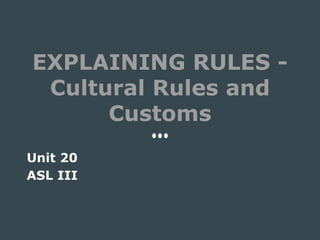
3d. Explaining Rules - Cultural Rules and Customs
- 1. EXPLAINING RULES - Cultural Rules and Customs Unit 20 ASL III
- 2. In our daily lives, we often find reason to discuss rules. They can be rules we live by such as driving rules, societal rules, cultural rules or school rules; or they can be the rules we play by such as rules for party games, card games, or children’s games. Explaining Rules
- 3. In this unit, you will learn to give clear instruction or explanations using classifiers and conditional sentences, rhetorical questions, and relative clauses. You will learn rule-related vocabulary needed to achieve this goal. You will develop strategies for explaining rules while playing a game and learn to use attention-getting behaviors to manage a group during a game. Explaining Rules
- 4. Cultural Rules and Customs 1. Describe situation (use a conditional clause to set up a hypothetical situation) 2. Explain rule or custom/behavior that is appropriate or inappropriate. 3. Contrast with another culture’s views.
- 5. Cultural Rules and Customs appropriate, acceptable inappropriate, unacceptable Use these signs to describe appropriate/inappropriate behavior.
- 6. Rule 9 - Public Display of Affection Stefanie compares the appropriateness of holding hands as a public display of affection in the United States and in Japan. Gloss: HERE AMERICA, MAN, WOMAN OUTSIDE WALK, BCL “hold hands” FINE++. IX-loc “there” JAPAN BCL “hold hands” “wave-no” !WRONG! Rules 9-11 show the signer explaining the appropriateness of certain behaviors in one culture and then contrasting them with how they are viewed by another culture. Notice the signs used to discuss behavior.
- 7. Rule 10 - Showing Respect to Elders John compares the appropriateness of children making eye contact with elders as a show of respect in China and in the United States. Gloss: IX-loc “there” CHINA PEOPLE OUT++ TALK CHILDREN SCL “eye contact” NOT FINE, MUST SCL “look down” RESPECT. HERE AMERICA, NOT-MATTER, SCL “eye contact” OKAY. Rules 9-11 show the signer explaining the appropriateness of certain behaviors in one culture and then contrasting them with how they are viewed by another culture. Notice the signs used to discuss behavior.
- 8. Rule 11 - Interpretation of Burping Stefanie discusses how people in Arab countries and in the United States interpret burping at the end of a meal. Gloss: IX-loc “there” fs- ARAB COUNTRY, EAT FINISH, ECL “burp” SHOULD MEAN FOOD !DELICIOUS! HERE AMERICA, EAT FINISH, ECL “burp” “wave-no” NOT+POLITE. Rules 9-11 show the signer explaining the appropriateness of certain behaviors in one culture and then contrasting them with how they are viewed by another culture. Notice the signs used to discuss behavior.
- 9. In the next two examples, the signer explains how people in two different cultures say good-bye and schedule workdays. The “TENDS- TO” sign is used to denote behavior that is typical or common. Note: This sign can be one-handed or two-handed. Cultural Customs
- 10. Custom 1 - Typical Workday Signers use contrastive structure to establish two groups when comparing two cultures, one “here” and the other “there.” Signers reference the group by referring to the space designated to discuss appropriate behavior for that group. These two signs are used to designate the space. If you review earlier segments, you will see signers using the same signs to reference the two groups. Stefanie explains how people in the United States and in Spain have different ways of scheduling a typical workday.
- 11. Custom 2 - Saying Good- byes John uses a different contrast strategy to discuss two groups of people in the same country. To contrast the two groups of people in the United States, John uses space to the left and right of him to represent Deaf and hearing people. Then he references these spaces to contrast how each group says good-byes. John uses the “DURING/WHILE” sign as a transition to describing how that behavior manifests itself in the second group. John compares the ways Deaf people and hearing people say their good-byes.
- 12. Review Throughout this presentation, you have learned the following: □ Cultural Rules and Customs (basic sequence): 1. Describe situation (use a conditional clause to set up a hypothetical situation). 2. Explain rule or custom/behavior that is appropriate or inappropriate. 3. Contrast with another culture’s views. □ Appropriate and Inappropriate Behavior Signs □ Explaining Cultural Customs using contrastive structure